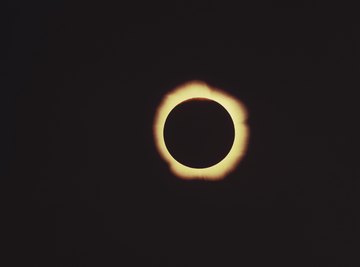
During orbit, the Earth sometimes comes between the sun and the moon during a full moon. It blocks sunlight that would normally reflect off the moon. Earth’s shadow travels across the moon, creating a lunar eclipse where the moon appears to have a red glow. A solar eclipse occurs when the moon comes between the Earth and the sun. Sunlight is blocked by the moon, which becomes dark in an area about 100 miles wide. Solar eclipses happen only twice a year at the new moon, and locations where they are visible vary. You can make models to see how lunar and solar eclipses appear.
Lunar Eclipse
Position the globe about 4 feet from a wall. Place the work lights so they will shine broadly on the side of the globe opposite the wall. Turn on the work lights and adjust them as necessary.
Turn off the room lights. Ask a partner to stand with his back to the wall and with the globe 2 feet to his left. Ask him to hold the paper plate “moon” in front of him so that it is fully illuminated by the “sun.”
Ask your partner to begin to side step slowly to his left. As he enters the shadow of the "Earth" (globe) blocking the "sun" (lights), the "moon" (paper plate) will enter the penumbra, or lighter shadow, followed by the umbra, or darker shadow. When it enters the umbra, the lunar eclipse is visible on Earth.
Ask your partner to begin moving again. Watch the “moon” as it “orbits” toward the other side of the “Earth.”
Solar Eclipse
- 2 work lights on stands
- Globe on a 4-foot stand
- Paper plate
- Kabob skewer
- 1-inch diameter Styrofoam ball
- 4-inch light-colored rubber ball
Never look directly at the sun during an actual solar eclipse to prevent permanent eye damage. Use an approved viewing device.
Push a skewer into the Styrofoam ball to model the moon. Take a partner outside on a sunny day and bring the “moon” and the rubber ball “Earth.”
Hold the "Earth" near the ground. Have your partner walk about 10 feet away from you, toward the sun. She should hold the "moon" so it blocks the sun from shining on the "Earth." As she looks at the "Earth," a small dark shadow (umbra) surrounded by a lighter, fuzzy shadow (penumbra) should be visible to illustrate the solar eclipse.
Ask your partner to move the "moon" slowly so its shadow moves across the "Earth." As the moon moves farther away, the umbra will disappear. Observers who see only the penumbra see a partial solar eclipse. Change places with your partner and repeat the demonstration.
Things You'll Need
Warnings
References
Warnings
- Never look directly at the sun during an actual solar eclipse to prevent permanent eye damage. Use an approved viewing device.
About the Author
Annette Strauch has been a writer for more than 30 years. She has been a radio news journalist and announcer, movie reviewer for Family Movie Reviews Online, chiropractic assistant and medical writer. Strauch holds a Master of Arts in speech/broadcast journalism from Bob Jones University, where she also served on the faculty of the radio/TV department.
Photo Credits
Comstock Images/Comstock/Getty Images
